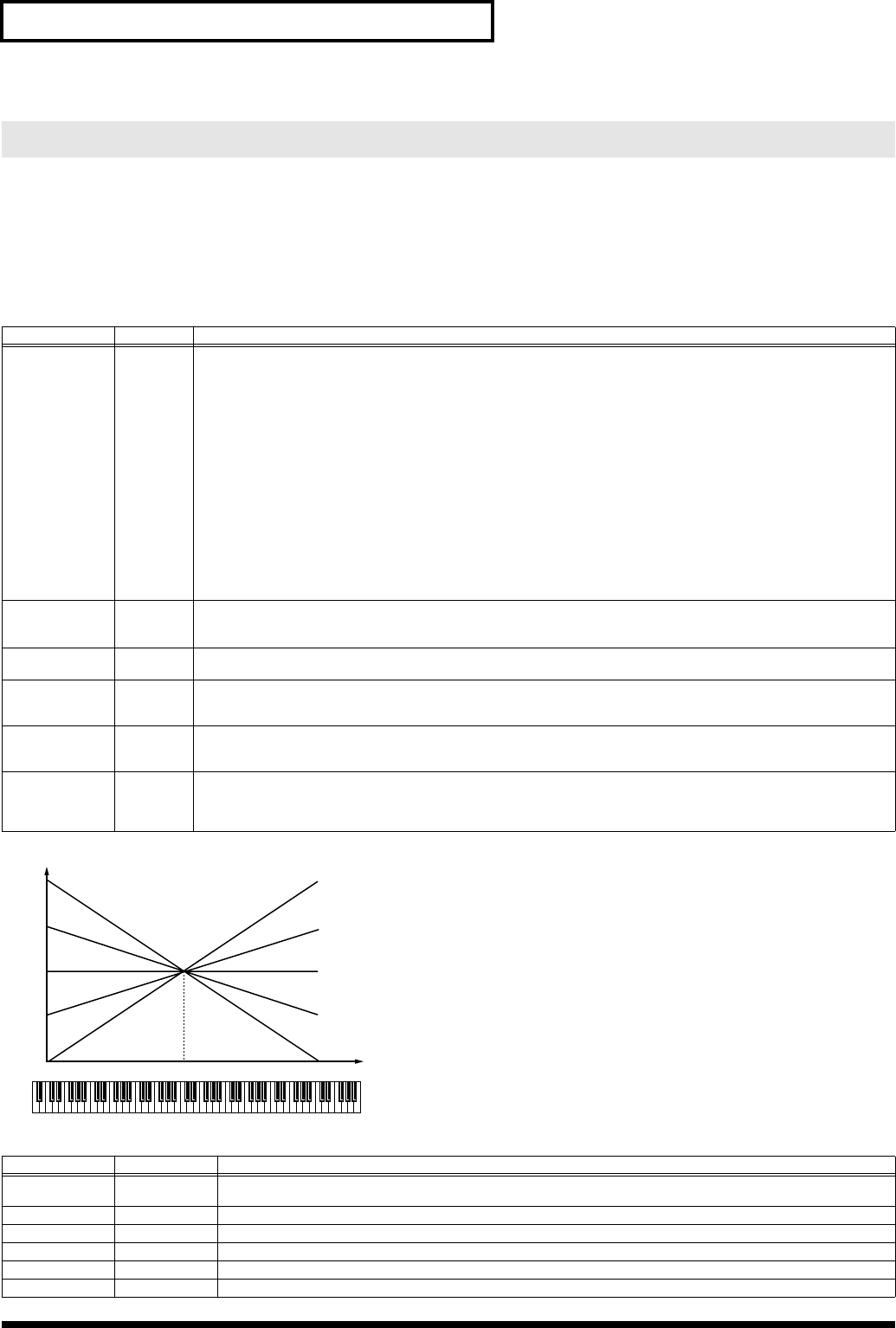
46
Creating a Patch
An LFO (Low Frequency Oscillator) causes change over a cycle in a sound. Each tone has two LFOs (LFO1/LFO2), and these can be used to
cyclically change the pitch, cutoff frequency and volume to create modulation-type effects such as vibrato, wah and tremolo. Both LFOs have the
same parameters so only one explanation is needed.
LFO 1–2
Parameter marked with a “
★
” can be controlled using specified MIDI messages
(Matrix Control, p. 44)
fig.T-KF.e
Parameter marked with a “
★
” can be controlled using specified MIDI messages
(Matrix Control, p. 44)
Modulating Sounds/Output
Parameter
Value Explanation
Wave Form
SIN,
TRI,
SAWU,
SAWD,
SQR,
RND, BD-
U, BD-D,
TRP, S&H,
CHS,
VSIN,
STEP
Waveform of the LFO
SIN:
Sine wave
TRI:
Triangle wave
SAWU:
Sawtooth wave
SAWD:
Sawtooth wave (negative polarity)
SQR:
Square wave
RND:
Random wave
BD-U:
Once the attack of the waveform output by the LFO is allowed to develop in standard fashion, the waveform then con-
tinues without further change.
BD-D:
Once the decay of the waveform output by the LFO is allowed to develop in standard fashion, the waveform then con-
tinues without further change.
TRP:
Trapezoidal wave
S&H:
Sample & Hold wave (one time per cycle, LFO value is changed)
CHS:
Chaos wave
VSIN:
Modified sine wave. The amplitude of a sine wave is randomly varied once each cycle.
STEP:
A waveform generated by the data specified by LFO Step 1–16. This produces stepped change with a fixed pattern sim-
ilar to a step modulator.
* If you set this to “BD-U” or “BD-D,” you must turn the Key Trigger parameter to “ON.” If this is “OFF,” it will have no effect.
Rate
★
0–127,
Note
Modulation speed of the LFO
LFO Rate sets the beat length for the synchronized tempo is synchronized with the tempo set in a sequencer.
* This setting will be ignored if the Waveform parameter is set to “CHAOS.”
Rate Detune
0–127 Makes subtle changes in the LFO cycle rate (Rate parameter) each time a key is pressed.
Higher settings will cause greater change. This parameter is invalid when Rate is set to “note.”
Offset -100– +100 Raises or lowers the LFO waveform relative to the central value (pitch or cutoff frequency).
Positive (+) settings will move the waveform so that modulation will occur from the central value upward. Negative (-) set-
tings will move the waveform so that modulation will occur from the central value downward.
Delay Time 0–127 Time elapsed before the LFO effect is applied (the effect continues) after the key is pressed (or released)
When using violin, wind, or certain other instrument sounds in a performance, rather than having vibrato added immediately
after the sounds are played, it can be effective to add the vibrato after the note is drawn out somewhat.
Delay Time KF
(Time Keyfol-
low)
-100– +100 Adjusts the value for the Delay Time parameter depending on the key position, relative to the C4 key (center C).
To decrease the time with each higher key that is pressed in the upper registers, select a positive value; to increase the elapsed
time, select a negative value. Larger settings will produce greater change. If you do not want the elapsed time to change ac-
cording to the key pressed, set this to “0.”
Parameter
Value Explanation
Fade Mode
ON <, ON >,
OFF <, OFF >
How the LFO will be applied
Fade Time 0–127 Time over which the LFO amplitude will reach the maximum (minimum)
Key Trigger OFF, ON Specifies whether the LFO cycle will be synchronized to begin when the key is pressed (ON) or not (OFF).
Pitch Depth
★
-63– +63
How deeply the LFO will affect pitch
TVF Depth
★
-63– +63
How deeply the LFO will affect the cutoff frequency
TVA Depth
★
-63– +63
How deeply the LFO will affect the volume
C4C3C2C1 C5 C6 C7
0
+50
+100
-50
-100
Key
Time
Time Keyfollow
JUNO-G_e.book 46 ページ 2006年2月13日 月曜日 午後2時44分


















